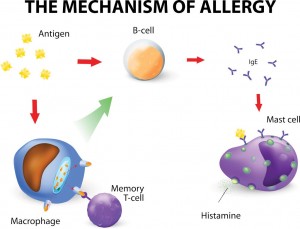Early this year on January 19th, the Canadian Federal Inspection Agency (CFIA) issued a notice to recall Mann’s Mediterranean Style snap peas due to not declaring the presence of allergens, specifically mustard, sesame, soy and wheat in the toppings and dressing. The allergens were first identified by the manufacturer and they had immediately halted distribution to their exclusive Walmart and Sobeys retailers across Canada. Fortunately, there had not been any reported hospitalizations or deaths, but individuals with hypersensitivities were advised to dispose or return the product to the retailer. Given that the best before date was January 25th, remaining products should have reached the end of its shelf life by the end of the week.
Mechanism and Characteristics of Food Allergies
Food allergy is a health concern that should not be overlooked. According to Soller et al.’s cross-sectional study (2012), adverse reactions to one or more allergens were self-reported by 6.67% of Canadians. Unfortunately, these numbers are expected to increase (Hengel, 2007).

Courtesy of Mona Dave (2015) from http://childrensgimd.com/digestive-disorders-in-children/food-allergies-in-children/
Food allergies are classified as a category of hypersensitivity where the immune response recognizes and abnormally believes the offending food or component to be harmful. The mechanism of an allergic response commences when the ingested allergen, which is typically a protein, crosses the intestinal barrier to the bloodstream and is recognized by circulating lymphocytes or white blood cells. These immune cells trigger the release of IgE antibodies that bind to mast cells. Through antibody-receptor interactions, inflammatory mediators, i.e. histamine, will be secreted to the surrounding tissues and result in adverse symptoms involving the skin, gastrointestinal, respiratory and/or cardiovascular systems. Initial exposure to the allergen is usually asymptomatic, but subsequent exposures may result in a quicker and more severe response. This is because some IgE-coated mast cells are already present and bind immediately to the same antigens to release histamine. Allergic symptoms may appear immediately after a few minutes or can be delayed up to 24 hours. They can be mild and localized to one or more body systems, such as nausea and vomiting from the gastrointestinal system. Alternatively, symptoms may progress in severity to affect all body systems, resulting in anaphylaxis or death. (Taylor, 2006)
Fact or Myth: Consuming processed foods reduce the risk of developing allergenic reactions.
Adding to the complexity of allergies, food processing will interfere with the allergenic capacity. IgE antibodies tend to bind well to a particular region on antigens, known as epitopes. These may be linear amino acid chains or 3D conformational structures. The binding affinity of IgE antibodies may be reduced during processing. For instance, high heat denatures the 3D conformation and fermentation cleaves the amino acid sequences. At the same time, allergenic capacity may be promoted as some epitopes are no longer hidden by the protein’s 3D conformation and can bind to IgE. Additional structures and IgE binding sites may be created from protein and peptide modifications during processing. Overall, further studies are necessary to develop a clearer answer for processed foods. (Hengel, 2007).
Prevention Strategies
Given the importance of allergens and potentially life-threatening consequences, CFIA is enforcing mandatory labelling for the top 10 allergens: wheat, soy, peanuts, tree nuts, sulphites, eggs, seafood, mustard, milk and sesame. Food manufacturers also need to take precautionary measures to avoid cross-contamination at the plant and practice proper product labeling. Consumers should periodically review the list of product recalls on the CFIA’s webpage. While there are currently no approved treatments, individuals with severe allergies should follow a strict diet and carry an EpiPen in case of a sudden reaction. Overall, prevention and awareness are pertinent to reducing food allergies.
What are your thoughts on the prevalence of food allergies? Do you think processed foods may be associated with the upward trend of food allergies?
Check out the following references and video (particularly about unpasteurized milk from times 14:40-15:13 and parasitic worms on allergies from times 23:09-25:44).
References
CFIA. (2015). Food Recall Warning (Allergen) – Mann’s brand Mediterranean Style Snap Pea Sensations recalled due to undeclared mustard, sesame, soy and wheat. Retrieved from http://www.inspection.gc.ca/about-the-cfia/newsroom/food-recall-warnings/complete-listing/2015-01-19/eng/1421730513089/1421730556698
Health Canada. (2012). Food Allergies and Intolerances. Retrieved from http://www.hc-sc.gc.ca/fn-an/securit/allerg/index-eng.php
Hengel, A. J. (2007). Food allergen detection methods and the challenge to protect food-allergic consumers. Analytical and Bioanalytical Chemistry 389(1):111-118.
Soller, L., Ben-Shoshan, M., Harrington, D. W., Fragapane, J., Joseph, L., St. Pierre, Y., Godefroy, S. B., La Vieille, S., Elliott, S. J. & Clarke, A. E. (2012). Overall prevalence of self-reported food allergy in Canada. Journal of Allergy and Clinical Immunology 130(4):986:988.
Taylor, S. (2006). The nature of food allergy. In S. J. Koppelman & S. L. Hefle (Eds.), Detecting Allergens in Food (pp.3-20). Boca Raton, FL:Woodhead Publishing Limited, Boca Raton.

